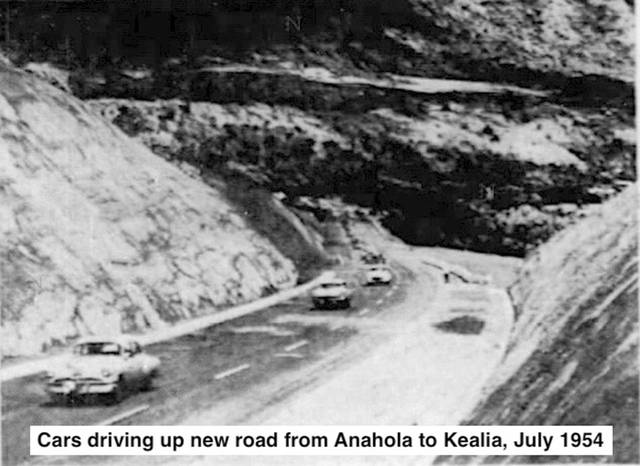On July 21, 1954, the newly constructed Anahola-
Kealia highway was formally opened at ceremonies held on it in Anahola that were attended by about 500 persons.
Acting Governor Farrant L. Turner (the first commanding officer of the Army’s famous World War II-era 100th Infantry Battalion) presided at a tape cutting ceremony, after which Ray Mant of Anahola (who would become coach of the newly organized Kauai Canoe and Racing Association in 1955) noted in his dedication speech that the road took about 10 months to complete and offered employment to Anahola residents.
An entertainment program directed by Mrs. Emmaline Lovell White of Anahola was followed by a procession of nearly 100 cars driven behind the acting governor’s car for the first trip over the new road.
Fred L. Schumacher, Territorial District Engineer on Kauai, supervised road construction of the $555,756 federal aid highway; the prime contractor was Walker-Moody Construction Co.; and paving was done by Hawaiian Bitumuls Co.
The two-lane, 24-foot-wide, 3.4-mile-long road of asphaltic concrete replaced the old, narrow, twisting 5.2-mile main government road, thereafter known as Kealia Road, which begins off Kuhio Highway in Kealia and heads uphill past the one-time locale of Kumukumu Camp, the Spalding Monument and the former cane road to Waipahee Slippery Slide (now closed to the public), across old Makee Sugar Co. sugar train tracks, past Anahola School (now Kamehameha Preschool), and on to Anahola.
But it would not be until 1957, when the initial increment of Hawaiian Homes Commission residential home lots were built at Anahola, that Lihue Plantation’s Waiahi Electric Co. extended its power facilities to provide electric power to Anahola for the very first time.
Previously, Anahola residents had made do with kerosene stoves and lamps, refrigerators run by gas or kerosene, heaters operated with similar fuel, and gasoline generators as substitutes for electric power.


